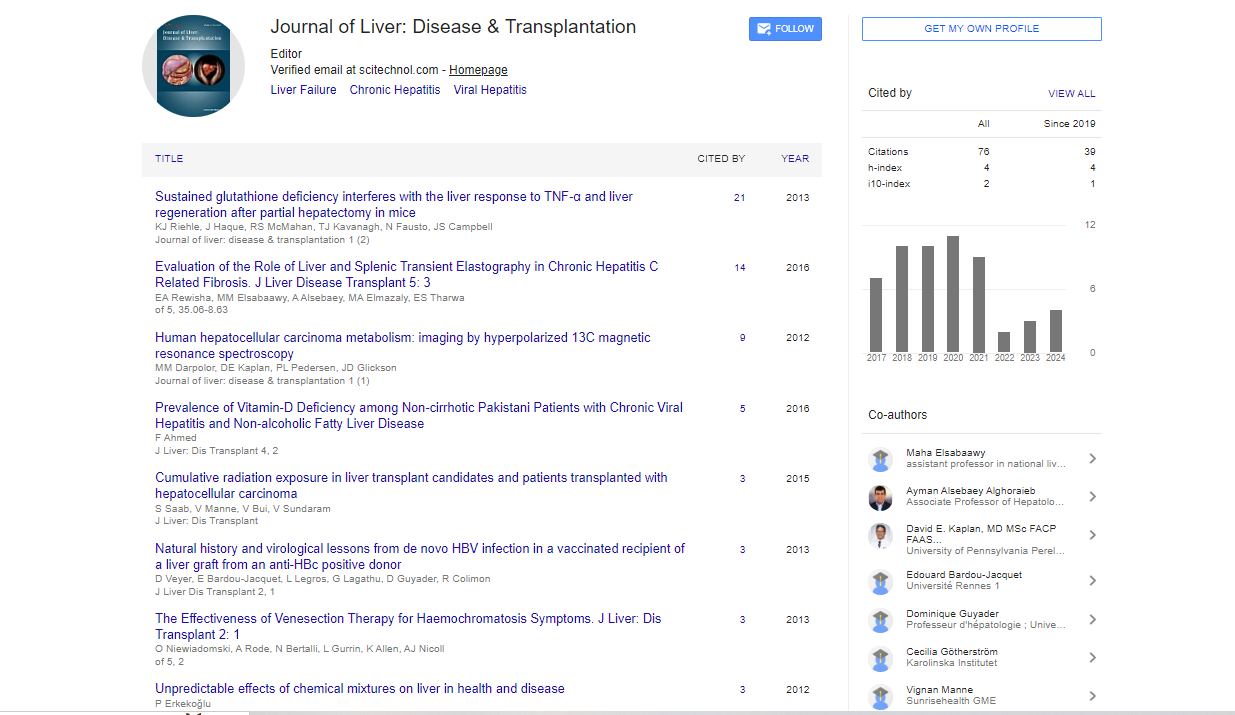Perspective, J Liver Disease Transplant Vol: 13 Issue: 1
A Comprehensive Review on the Enigma of Biliary Atresia
Nehal Gupta*
1Department of Surgery, University of Texas Southwestern Medical Center, Dallas, United States of America
*Corresponding Author: Nehal Gupta,
Department of Surgery, University of
Texas Southwestern Medical Center, Dallas, United States of America
E-mail: nehalg@utsouthwestern.edu
Received date: 12 February, 2024, Manuscript No. JLDT-24-135112;
Editor assigned date: 14 February, 2024, PreQC No. JLDT-24-135112 (PQ);
Reviewed date: 28 February, 2024, QC No. JLDT-24-135112;
Revised date: 06 March, 2024, Manuscript No. JLDT-24-135112 (R);
Published date: 13 March, 2024, DOI: 10.4172/2325-9612.1000256.
Citation: Gupta N (2024) A Comprehensive Review on the Enigma of Biliary Atresia. J Liver Disease Transplant 13:1.
Description
Biliary atresia stands as a formidable challenge in pediatric hepatology, characterized by progressive obstruction and obliteration of the extrahepatic bile ducts in infancy. This enigmatic condition, with an incidence of approximately 1 in 10,000 to 1 in 15,000 live births, manifests as neonatal jaundice, hepatomegaly, and conjugated hyperbilirubinemia, ultimately culminating in liver failure if left untreated. Despite decades of study, the etiology and pathogenesis of biliary atresia remain elusive, posing diagnostic and therapeutic dilemmas for clinicians worldwide. Biliary atresia typically manifests within the first few weeks to months of life, presenting a spectrum of clinical features ranging from subtle jaundice to overt signs of cholestasis and liver dysfunction. Neonates with biliary atresia often exhibit persistent jaundice beyond the first two weeks of life, accompanied by pale stools, dark urine, and hepatomegaly. Conjugated hyperbilirubinemia, evidenced by elevated direct bilirubin levels, serves as a hallmark of the disease, reflecting impaired bile flow and hepatocellular injury. Furthermore, affected infants may experience failure to thrive, coagulopathy, and hepatosplenomegaly, heralding the progression to end-stage liver disease in the absence of timely intervention.
The diagnosis of biliary atresia hinges on a comprehensive diagnostic workup encompassing clinical evaluation, biochemical testing, imaging studies, and confirmatory procedures. Laboratory investigations typically reveal elevated serum conjugated bilirubin, transaminases, and Gamma-Glutamyl Transferase (GGT), indicative of cholestasis and hepatocellular injury. Moreover, abdominal ultrasonography serves as an initial screening modality, facilitating the visualization of gallbladder abnormalities, bile duct dilatation, and liver parenchymal changes. However, the definitive diagnosis of biliary atresia necessitates invasive procedures, including Hepatobiliary Scintigraphy (HIDA scan) and intraoperative cholangiography. HIDA scan, utilizing technetium-99m-labeled iminodiacetic acid derivatives, aids in assessing bile excretion and hepatobiliary clearance, with delayed or absent tracer uptake suggestive of biliary obstruction. In contrast, intraoperative cholangiography involves the injection of contrast dye into the biliary tree during exploratory laparotomy, facilitating direct visualization of the biliary anatomy and confirming the absence of patent bile ducts.
Therapeutic interventions
The management of biliary atresia entails a multi-disciplinary approach aimed at palliating symptoms, optimizing nutritional status, and addressing hepatobiliary obstruction. Kasai portoenterostomy, first described by remains the cornerstone of treatment, offering a surgical conduit to bypass the obstructed bile ducts and restore bile flow. During the procedure, the porta hepatis is dissected, and a Roux-en-Y hepaticoportoenterostomy is created to anastomose the hepatic duct remnants to a jejunal loop. Despite its efficacy, Kasai portoenterostomy is associated with variable outcomes, with approximately 60%-70% of infants achieving temporary bile drainage and delaying the progression to end-stage liver disease. However, the long-term success of the procedure hinges on timely intervention, with early surgery (<60 days of life) correlating with improved bile drainage and prolonged native liver survival. Nevertheless, a significant proportion of patients eventually develop progressive biliary cirrhosis, necessitating liver transplantation as the definitive therapeutic option.
The pathogenesis of biliary atresia remains a subject of intense investigation, with emerging evidence implicating genetic, infectious, and immune-mediated mechanisms in disease pathophysiology. Genetic studies have identified several susceptibility loci and candidate genes associated with biliary atresia, suggesting a multifactorial etiology involving both genetic predisposition and environmental triggers. Furthermore, viral infections, particularly Cytomegalovirus (CMV) and reovirus, have been implicated in triggering bile duct injury and immune dysregulation, leading to progressive fibrosis and obliteration. Moreover, dysregulated immune responses, including aberrant activation of T cells and dysbiosis of the gut microbiota, have been proposed as potential drivers of bile duct inflammation and fibrogenesis in biliary atresia. Immunomodulatory therapies targeting inflammatory cytokines, such as interferon gamma and tumor necrosis factor alpha, have shown promise in preclinical models and early-phase clinical trials, offering a glimmer of hope for disease modification and improved outcomes.
Conclusion
Biliary atresia remains a complex and challenging condition in pediatric hepatology, necessitating early recognition, timely intervention, and ongoing study efforts to unravel its etiology and pathogenesis. Despite significant advances in diagnostic modalities and surgical techniques, the long-term prognosis of biliary atresia remains guarded, underscoring the need for innovative therapeutic strategies and personalized patient management. Moving forward, interdisciplinary collaboration and translational study endeavors hold promise in improving outcomes and enhancing our understanding of this enigmatic disease.
 Spanish
Spanish  Chinese
Chinese  Russian
Russian  German
German  French
French  Japanese
Japanese  Portuguese
Portuguese  Hindi
Hindi 